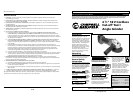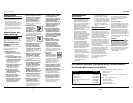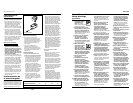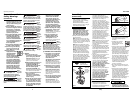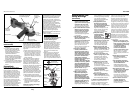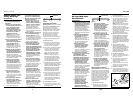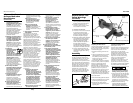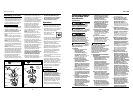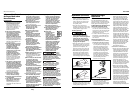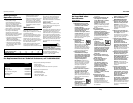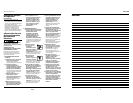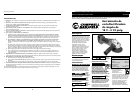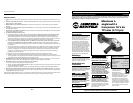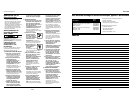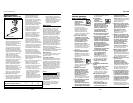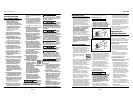
8) Additional Safety Instructions
for Grinding and Cutting off
Operations
a)Always use guard designed
for the type of wheel you are
using. The guard must be
securely attached to the
power tool and positioned
for maximum safety, so the
least amount of wheel is
exposed towards the
operator. The guard helps to
protect operator from the
broken wheel fragments and
accidental contact with wheel.
b)Use only wheel types that are
recommended for your
power tool and the specific
guard designed for the
selected wheel. Wheels for
which the power tool was not
designed cannot be adequately
guarded and are unsafe.
c)Wheels must be used only for
recommended applications.
For example: do not grind with
the side of the cut-off wheel.
Abrasive cut-off wheels are
intended for peripheral grinding,
side forces applied to these wheels
may cause them to shatter.
d) Always use undamaged
wheel flanges that are of
correct size and shape for
your selected wheel. Proper
wheel flanges support the wheel
thus reducing the possibility of
wheel breakage. Flanges for cut-
off wheels may be different
from grinding wheel flanges.
e)Do not use worn down
wheels from larger power
tools. A wheel intended for a
larger power tool is not suitable
for the higher speed of a smaller
tool and may burst.
f)Grinding/cutting operations
typically produce sparks
which are capable of starting
fires and burns. Direct the
sparks away from flammable
materials, bystanders, and the
person operating the tool.
9) Additional Safety Instructions
for Grinding and Cutting off
Operations - Additional Safety
Warnings Specific for Abrasive
Cutting off Operations
a)Do not “jam” the cut-off
wheel or apply excessive
pressure. Do not attempt to
make an excessive depth of
cut. Overstressing the wheel
increases the loading and
susceptibility to twisting or
binding of the wheel in the cut
and the possibility of kickback or
wheel breakage.
b)Do not position your body in
line with and behind the
rotating wheel. When the
wheel, at the point of operation,
is moving away from your body,
the possible kickback may propel
the spinning wheel and the
power tool directly at you.
c)When wheel is binding or
when interrupting a cut for
any reason, switch off the
power tool and hold the power
tool motionless until the wheel
comes to a complete stop.
Never attempt to remove the
cut-off wheel from the cut
while the wheel is in motion
otherwise kickback may occur.
Investigate and take corrective
action to eliminate the cause of
wheel binding.
d)Do not restart the cutting
operation in the workpiece.
Let the wheel reach full speed
and carefully reenter the cut.
The wheel may bind, walk up or
kickback if the power tool is
restarted in the workpiece.
e)Support panels or any
oversized workpiece to
minimize the risk of wheel
pinching and kickback. Large
workpieces tend to sag under
their own weight. Supports must
be placed under the workpiece
near the line of cut and near the
edge of the workpiece on both
sides of the wheel.
f)Use extra caution when
making a “pocket cut” into
existing walls or other blind
areas. The protruding wheel
may cut gas or water pipes,
electrical wiring or objects that
can cause kickback.
ADDITIONAL PRECAUTIONS:
Sanding Paint: Sanding of lead-based
paint is NOT RECOMMENDED due to
the difficulty of controlling the
contaminated dust. The greatest
danger of lead poisoning is to children
and pregnant women. Lead-based
paint should only be removed by a
professional. Since it is difficult to
identify whether or not a paint
contains lead without a chemical
analysis, we recommend the following
precautions when sanding any paint:
A) PERSONAL SAFETY
1) No children or pregnant women
should enter the work area where
the paint sanding is being done
until all clean up is completed.
2) A dust mask or respirator should be
worn by all persons entering the
work area. The filter should be
replaced daily or whenever the
wearer has difficulty breathing.
Note: Only those dust masks
suitable for working with lead
paint dust and fumes should be
used. Ordinary painting masks do
not offer this protection. See your
local hardware dealer for the
proper (NIOSH approved) mask.
3) No eating, drinking, or smoking should
be done in the work area to prevent
ingesting contaminated paint particles.
Workers should wash and clean up
BEFORE eating, drinking, or smoking.
Articles of food, drink, or smoking
should not be left in the work area
where dust would settle on them.
4) Some wood contains preservatives
which can be toxic. Take extra care
to prevent inhalation and skin
contact when working with these
materials. Request and follow any
safety information available from
your material supplier.
B) ENVIRONMENTAL SAFETY
1) Paint should be removed in such a
manner as to minimize the amount
of dust generated.
6
Operating Instructions
General Power Tool
Safety Warnings
(Continued)
31 Sp
DG472500DI
d) Use siempre rebordes de ruedas
sin dañar que sean del tamaño
y forma correctos para la rueda
que haya seleccionado. Los
rebordes de ruedas adecuados le
brindan soporte a la rueda a la vez
que reducen la posibilidad de
rotura de la rueda. Los rebordes
para las ruedas de corte pueden ser
diferentes que los de las ruedas de
rectificado.
e)No use ruedas desgastadas
de herramientas eléctricas
más grandes. Una rueda
diseñada para una herramienta
eléctrica más grande no es
adecuada para la velocidad más
alta de una herramienta más
pequeña y podría estallar.
f)Las operaciones de
rectificado/corte producen
chispas que pueden iniciar
incendios y quemaduras.
Dirija las chispas lejos de
materiales inflamables, personas
cercanas y de usted mismo
cuando maneja la herramienta.
9) Instrucciones de seguridad
adicionales para las operaciones
de rectificado y corte –
Advertencias de seguridad
adicionales específicas para las
operaciones de corte abrasivo
a)No “atore” la rueda de corte
niaplique presión excesiva.
Nointente hacer un corte
excesivamente profundo.
Presionar excesivamente la rueda
aumenta la carga y la probabilidad
de doblar o atascar la rueda en el
corte y la posibilidad de
contragolpe o rotura de la rueda.
b)No ubique su cuerpo en línea
y detrás la rueda giratoria.
Cuando la rueda, en el punto de
operación, se mueve en dirección
opuesta a usted, el posible
contragolpe puede impulsar la
rueda en movimiento y la
herramienta eléctrica
directamente hacia usted.
c)Cuando la rueda se está
atorando o cuando se
interrumpe el corte por
cualquier motivo, apague la
herramienta eléctrica y
sostenga la herramienta
inmóvil hasta que la rueda se
detenga por completo.
Nuncaintente retirar la rueda
de corte del lugar del corte
mientras la rueda está en
movimiento ya que puede
ocurrir un contragolpe.
Investigue y tome acciones
correctivas para eliminar la causa
del atascamiento de la rueda.
d)No reinicie la operación de
corte sobre la pieza de trabajo.
Deje que la rueda alcance la
máxima velocidad y vuelva a
ingresar al corte con sumo
cuidado. La rueda puede atascarse,
rebotar o contragolpear si se
vuelve a encender la herramienta
eléctrica sobre la pieza de trabajo.
e)Use soportes de apoyo para
paneles o cualquier pieza de
trabajo de tamaño excesivo
para minimizar el riesgo de
que la hoja muerda o
contragolpee. Las piezas de
trabajo grandes tienden a
curvarse por su propio peso.
Se deben colocar apoyos debajo
de la pieza de trabajo, cerca de la
línea de corte y cerca del borde
de la pieza de trabajo en ambos
lados de la rueda.
f)Tenga extremo cuidado al
hacer un “corte en bolsillo”
enparedes existentes u otras
áreas ciegas. Lo que sobresale de
la rueda puede cortar tuberías de
gas o agua, cableado eléctrico u
objetos que pueden causar un
contragolpe.
PRECAUCIONES ADICIONALES:
Lijado de pintura: NO SE RECOMIENDA
lijar pintura que contiene plomo ya que
es difícil controlar el polvo contaminado.
El mayor riesgo de envenenamiento con
plomo lo tienen los niños y las mujeres
embarazadas. Un profesional debe
quitar la pintura que contiene plomo.
Debido a la dificultad para identificar si
una pintura contiene plomo o no sin un
análisis químico, recomendamos las
siguientes precauciones cuando lije
cualquier pintura:
A) SEGURIDAD PERSONAL
1) Ningún niño ni ninguna mujer
embarazada deberán ingresar al
área de trabajo mientras se lija
pintura y hasta que no se haya
terminado de limpiar.
2) Todas las personas que ingresen al
área de trabajo deberán usar una
máscara o respirador para polvo.
El filtro deberá reemplazarse a
diario o cuando el usuario tenga
dificultad para respirar.
Nota: se deberán usar únicamente
las máscaras para polvo aptas para
trabajar con polvo y humos de
pintura de plomo. Las máscaras para
pintura normales no proporcionan
esta protección. Consulte al
proveedor de su ferretería local para
que le indique la máscara
(aprobada por NIOSH) adecuada.
3) NO deberá comer, beber ni fumar en
el área de trabajo para evitar ingerir
partículas de pintura contaminadas.
Los trabajadores deberán lavarse y
limpiarse ANTES de comer, beber o
fumar. Los artículos de comida, bebida
o para fumar no deberán dejarse en el
área de trabajo donde el polvo pueda
asentarse.
4) Algunas maderas contienen
conservadores que pueden ser
tóxicos. Tenga especial cuidado para
evitar la inhalación y el contacto de la
piel con estos materiales. Solicite y
cumpla con toda la información de
seguridad disponible por parte de su
proveedor de materiales.
B) SEGURIDAD AMBIENTAL
1) La pintura se deberá quitar de un
modo que minimice la cantidad de
polvo que se genere.
2) Las áreas donde se esté quitando
la pintura deben sellarse con
coberturas plásticas de al menos
4 mils de grosor.
3) El lijado se debe realizar de modo
de reducir los restos del polvo de
pintura fuera del área de trabajo.
C) LIMPIEZA Y DESECHO
1) Todas las superficies del área de
trabajo deben aspirarse y limpiarse
por completo a diario durante el
proyecto. Las bolsas de filtro de la
Línea de corte
Figura 1
Figura 2
Información General
de Seguridad sobre
Herramientas
(Continuación)
Line of cut
Figure 1



